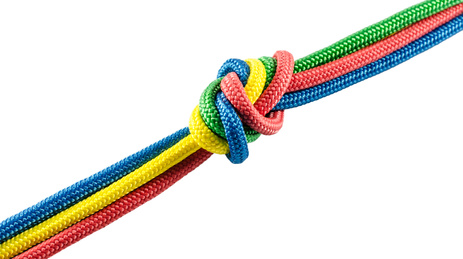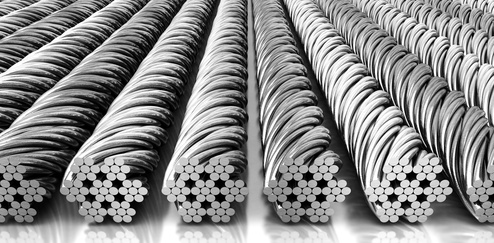Have any questions?
Leave a message and we will answer you:
Ropes and twines
Luxsol® makes a wide selection of ropes and twines to fill most any need. We have nylon, polyester twines and a great variety of ropes.
We have nylon, polyester twines and a great variety of ropes.
Ropes are an important component of cage aquaculture. They are used for the mooring lines, the grid system and for the netting frame (such as the rib-lines and down-lines, which distribute the forces on the cage net). Ropes are generally divided into two types:
Twisted rope
Twisted rope – with an S or Z torsion (either clockwise or anticlockwise twist), and usually composed of 3, 4 or 8 strands. Each strand consists of several twisted yarns. The tighter the twisting, the better the abrasion resistance, and the longerlasting the rope. A softer twist is generally preferred if splicing is needed. Softmedium twisting is mostly used in cage net production, owing to their being readily sewn by machine.

Braided rope
Braided rope – composed of a braided coat with 12, 16, 24 or 32 yarns, and an inner core made with twisted rope or braided yarns. Some braided rope can have a double coating in order to improve the abrasion resistance. Braided rope without any core is generally used when it is necessary having a good elasticity and resistance to torsion.
Ropes and lines are made of fibre lengths, twisted or braided together to provide tensile strength. They are used for pulling, but not for pushing. The availability of reliable and durable ropes and lines has had many consequences for the development and utility of fishing nets, and influences particularly the scale at which the nets can be deployed.
A rope is a group of yarns, plies, or strands that are twisted or braided together into a larger and stronger form. Ropes have tensile strength and so can be used for dragging and lifting, but are too flexible to provide compressive strength. As a result, they cannot be used for pushing or similar compressive applications. Rope is thicker and stronger than similarly constructed cord, line, string, and twine. Rope made from metal strands is called wire rope. Rope may be constructed of any long, stringy, fibrous material, but generally is constructed of certain natural or synthetic fibres. Synthetic fibre ropes are significantly stronger than their natural fibre counterparts, but also possess certain disadvantages, including slipperiness.
Twisted ropes are built up in three steps. First, fibres are gathered and spun into yarns. A number of these yarns are then formed into strands by twisting. The strands are then twisted together to lay the rope. The twist of the yarn is opposite to that of the strand, and that in turn is opposite to that of the rope. It is this counter-twist, introduced with each successive operation, which holds the final rope together as a stable, unified object. Traditionally, a three strand laid rope is called a plain- or hawser-laid, a four strand rope is called shroud-laid, and a larger rope formed by counter-twisting three or more multi-strand ropes together is called cable-laid. As a rule 93,5 and 187 TEX linear density ropes are used in fishing industry.
While rope may be made from three or more strands, modern braided rope consists of a braided (tubular) jacket over strands of fiber (these may also be braided).
Braided ropes are generally made from nylon, polyester, polypropylene or high performance fibers such as high modulus polyethylene (HMPE) and aramid.
Nylon is chosen for its strength and elastic stretch properties. However, nylon absorbs water and is 10-15% weaker when wet. Polyester is about 90% as strong as nylon but stretches less under load and is not affected by water. It has somewhat better UV resistance, and is more abrasion resistant. Polypropylene is preferred for low cost and light weight (it floats on water) but it has limited resistance to ultraviolet light, is susceptible to friction and has a poor heat resistance.
Braided ropes, that have no lay (or inherent twist) uncoil better if each alternate loop is twisted in the opposite direction, such as in figure-eight coils, where the twist reverses regularly and essentially cancels out.
Single braid consists of an even number of strands, eight or twelve being typical, braided into a circular pattern with half of the strands going clockwise and the other half going anticlockwise. The strands can interlock with either twill or plain weave. The central void may be large or small; in the former case the term hollow braid is sometimes preferred.
Double braid, also called braid on braid, consists of an inner braid filling the central void in an outer braid, that may be of the same or different material. Often the inner braid fibre is chosen for strength while the outer braid fibre is chosen for abrasion resistance.
In solid braid the strands all travel the same direction, clockwise or anticlockwise, and alternate between forming the outside of the rope and the interior of the rope. This construction is popular for general purpose utility rope but rare in specialized high performance line.
Kernmantle rope has a core (kern) of long twisted fibres in the center, with a braided outer sheath or mantle of woven fibres. The kern provides most of the strength (about 70%), while the mantle protects the kern and determines the handling properties of the rope (how easy it is to hold, to tie knots in, and so on). In dynamic climbing line, core fibres are usually twisted, and chopped into shorter lengths, which makes the rope more elastic. Static kernmantle ropes are made with untwisted core fibres and tighter braid, which causes them to be stiffer in addition to limiting the stretch.
Wire rope is a type of cable which consists of several strands of metal wire laid (twisted) into a helix.
The term cable is often used interchangeably with wire rope. However, in general, "wire rope" refers to diameter larger than 3/8 inch (9.52 mm). Sizes smaller than this are designated cable or cords. Initially wrought iron wires were used, but today steel is the main material used for wire ropes.
Steel wires for wire ropes are normally made of non-alloy carbon steel with a carbon content of 0.4 to 0.95%. The very high strength of the rope wires enables wire ropes to support large tensile forces and to run over sheaves with relatively small diameters.

